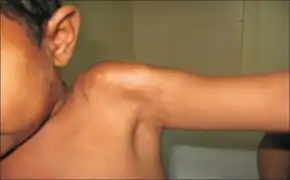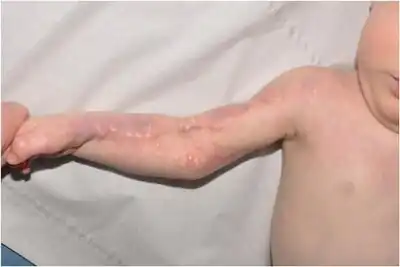Progressive osseous heteroplasia
| Progressive osseous heteroplasia | |
|---|---|
 | |
| Cutaneous coalesced plaques over the left shoulder | |
| Specialty | Dermatology |
Progressive osseous heteroplasia is a cutaneous condition characterized by cutaneous or subcutaneous ossification.[1]
According to the Progressive Osseous Heteroplasia Association:
Progressive Osseous Heteroplasia (POH) is a rare genetic condition in which the body makes extra bone in locations where bone should not form. Extra bone develops inside skin, subcutaneous tissue (fat tissue beneath the skin), muscles, tendons, and ligaments. This ”out of place extra bone formation” is commonly referred to as heterotopic ossification. In people with POH, nodules and lace-like webs of extra bone extend from the skin into the subcutaneous fat and deep connective tissues, and may cross joints. Extra bone formation near the joints may lead to stiffness, locking, and permanent immobility.”[2]
It is associated with GNAS.[3]

See also
References
- ↑ Rapini, Ronald P.; Bolognia, Jean L.; Jorizzo, Joseph L. (2007). Dermatology: 2-Volume Set. St. Louis: Mosby. ISBN 978-1-4160-2999-1.
- ↑ "About POH Disease". Archived from the original on 2012-06-11. Retrieved 2012-06-15.
- ↑ Adegbite NS, Xu M, Kaplan FS, Shore EM, Pignolo RJ (July 2008). "Diagnostic and mutational spectrum of progressive osseous heteroplasia (POH) and other forms of GNAS-based heterotopic ossification". Am. J. Med. Genet. A. 146A (14): 1788–96. doi:10.1002/ajmg.a.32346. PMC 2564798. PMID 18553568.
External links
| Classification |
|---|